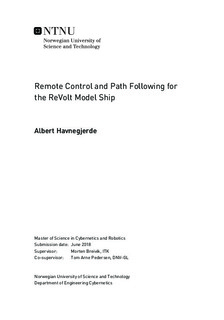Remote Control and Path Following for the ReVolt Model Ship
Abstract
The guidance system of the 3 meter long ReVolt is expanded to include a 2-D path following system using the Line-of-Sight (LOS) guidance principle and lookahead-based steering algorithm for computing the heading reference signal. Reference models for the heading and speed motion is added to smooth the reference signals and create higher order derivatives for the controllers. A separate software for visually placing waypoints in a navigation map and transmitting them ReVolt is developed in C++ using Qt Creator. This software is used for remote monitoring and control of ReVolt during simulations and experimental tests. An improved heading controller for maintaining the correct heading during course-keeping and course-changing maneuvers is implemented. A 1st order Nomoto model is used to compute the parameters in the model-based feedforward term and the feedback gains. A speed controller consisting of a feedforward and feedback term is implemented as well.
In transit, the two aft azimuth thrusters are constrained to ±45 degrees by the control allocation and the bow thruster remains retracted. This leaves the sway motion uncontrolled, resulting in an underactuated configuration. The source code for controllers and LOS steering algorithm are written in C++ and launched using Robot Operating System (ROS) from the ReVolt onboardcomputer.
System identification and testing of the guidance and control system are first done usingReVolt s Digital Twin in the simulator developed by DNV GL. Full-scale experimentaltests to assess the performance of the implemented solutions with ReVolt are done at Dora 1 harbor basin in Trondheim.
